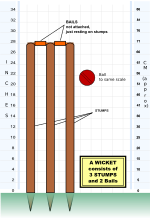Wicket
In the sport of cricket , the word wicket has several meanings:
Meanings of the term wicket
The wicket made up of the stumps
First of all, the wooden structure consisting of three bars (stumps) and two cross bars (bails) is called a wicket . There is one such wicket at each end of the pitch . The batsman ( batsman ) defends it with his bat before the thrower ( Bowler thrown) ball .
The wooden stick that is protected by the bat is called off stump . The middle wooden stick is called the middle stump . The wooden stick, which is only covered by the leg, is called leg stump . Depending on whether the batsman is right-handed or left-handed, the names for the wooden sticks change for off stump and leg stump.
The stump, made from one piece, has an approx. 8 cm long tip that is stuck into the ground (lawn) without any further fastenings. Higher quality stumps are made from English ash.
According to Rule 8 of the Laws of Cricket , the dimensions of the wicket must be as follows: Each stump is 71 cm (28 inches) above the ground. The three stumps are evenly spaced on the so-called bowling crease (line), so that the wicket is approx. 23 cm (9 inches) wide. The two bails (cross bars), which lie loosely in small depressions on the stumps, must not protrude more than 1.3 cm (1/2 inch) and are each approx. 11 cm long. In addition, there are other regulations for the dimensions of the stumps and bails. Other regulations apply to junior cricket.
In modern cricket the three wooden sticks are often stuck with sponsor logos.
In 2013 the International Cricket Council allowed the use of LED stumps in international matches. Since then, in addition to important international events, they have also been used in global league operations. The system was invented by former Australian cricketer Bronte Eckermann. The system provides that the LEDs in the bails and stumps light up red with the slightest touch. This is not only entertaining for the audience. In the slow motion repetition, the TV umpire can better recognize when the ball touches the stumps or bails.
Elimination of the batsman
The elimination of the batsman is also known as a wicket. In this case, the batsman is said to have lost his wicket . Conversely, this can be credited to the bowler who has then scored a wicket ( taken a wicket in English).
Partnership
The period of time during which two batsmen are in play together, and in particular the runs of the (batting) team that have been gained since the last elimination, is or are called partnership . In order to distinguish these partnerships from one another, they are referred to in turn as first wicket partnership, second wicket partnership, and so on. A new partnership always begins as soon as a batsman has left and a new batsman is used. The end of the tenth wicket or last wicket partnership is also the end of the inning .
Termination and interruption of the game
In a test match , the umpire (referee) ends the game day by removing the bails from the wickets. Even if the game is interrupted, such as rain, the umpire removes the bails and it is stumps .
The pitch
The word wicket is also often used for the cricket pitch itself. This is not correct under the Laws of Cricket , which only use the term pitch , but every cricket fan understands it.
Common errors
The wickets are not goals. This translation, which is often found in (sports) encyclopedias or dictionaries, is probably based on the misunderstanding that you would get points for hitting the “goal”. Furthermore, the wicket had in the history of cricket was originally the shape of a gate ( gate , not goal ) - the third stump was added later (1775).
Another reason for this mix-up is the fact that there are two wickets on the field, which is not due to the fact that there are two teams, but rather that two batsmen from one team, the batting team, are always in play at the same time . Not only is there a different word for goal in English and the wicket only remotely resembles a goal (no net, three vertical bars), it is crucial that it does not have the function of a goal. Incidentally, it is therefore also correct not to speak of posts and laths when referring to stumps and bails , but of bars and crossbars.
Since wicket cannot be translated as “goal”, “gatekeeper” or “goalkeeper” is also not a suitable translation for wicket keeper . This word also remains untranslated among German-speaking cricketers. It would also give a completely wrong impression as the wicket keeper does not protect the wicket but on the contrary tries to destroy it with the ball. On the other hand, it is the batsman's job to protect the wicket from destruction by knocking away the approaching ball.
Trivia
A phrase from a work ( The Birthday Party ) by Harold Pinter : "Who watered the wicket at Melbourne?" Here, too, wicket actually means the cricket pitch and the act referred to is unfair behavior on the part of an allegedly unknown participant in whom the playing characteristics of the pitch were changed overnight by watering during a test match .
Individual evidence
- ↑ Catalog cricket direct, United Kingdom. Memento from the Internet Archive , September 14, 2016
- ↑ The official cricket rules (Appendix A - The wickets) ( Memento of the original from June 13, 2010 in the Internet Archive ) Info: The archive link was inserted automatically and has not yet been checked. Please check the original and archive link according to the instructions and then remove this notice.
- ^ World T20: How do the lights on cricket stumps work?

